CMOS IMAGERS
�
CMOS Imagers
From Phototransduction to Image Processing
Edited by
Orly Yadid-Pecht
Ben-Gurion University,
Beer-Sheva, Israel
and
Ralph Etienne-Cummings
Johns Hopkins University,
Baltimore, U.S.A.
KLUWER ACADEMIC PUBLISHERS
NEW YORK, BOSTON, DORDRECHT, LONDON, MOSCOW
�
eBook ISBN:
Print ISBN:
1-4020-7962-1
1-4020-7961-3
©2004 Springer Science + Business Media, Inc.
Print ©2004 Kluwer Academic Publishers
Dordrecht
All rights reserved
No part of this eBook may be reproduced or transmitted in any form or by any means, electronic,
mechanical, recording, or otherwise, without written consent from the Publisher
Created in the United States of America
Visit Springer's eBookstore at:
and the Springer Global Website Online at:
http://www.ebooks.kluweronline.com
http://www.springeronline.com
�
Dedication
To our loved ones.
�
Contents
Dedication
Contributing Authors
Preface
Introduction
1. Fundamentals of Silicon-Based Phototransduction
HONGHAO JI AND PAMELA A. ABSHIRE
1.1
1.2
1.3
1.4
1.5
1.6
Introduction
Background physics of light sensing
Silicon-based photodetectors
Semiconductor image sensors
Information rate
Summary
2. CMOS APS MTF Modeling
IGOR SHCHERBACK AND ORLY YADID-PECHT
2.1
2.2
2.3
2.4
2.5
2.6
Introduction
Experimental details
Physical analysis
The unified model description
Results and discussion
Summary
v
ix
xi
xiii
1
2
8
31
39
49
53
62
63
67
68
72
�
viii
CMOS Imagers: From Phototransduction to Image Processing
3. Photoresponse Analysis and Pixel Shape Optimization for CMOS APS
IGOR SHCHERBACK AND ORLY YADID-PECHT
3.1
3.2
3.3
3.4
Introduction
Photoresponse model
Comparison with experimental results
CMOS APS pixel photoresponse prediction
for scalable CMOS technologies
3.5
Summary
4. Active Pixel Sensor Design: From Pixels to Systems
ALEXANDER FISH AND ORLY YADID-PECHT
4.1
4.2
4.3
4.4
Introduction
CMOS image sensors
APS system-on-a-chip approach
Summary
5. Focal-Plane Analog Image Processing
MATTHEW A. CLAPP, VIKTOR GRUEV,
AND RALPH ETIENNE-CUMMINGS
5.1
5.2
Introduction
Current-domain image processing:
5.3
5.4
the general image processor
Voltage-domain image processing:
the temporal difference imager
Mixed-mode image processing:
the centroid-tracking imager
5.5
Conclusions
6. CMOS Imager Non-Uniformity Correction Using
Floating-Gate Adaptation
MARC COHEN AND GERT CAUWENBERGHS
6.1
6.2
6.3
6.4
6.5
6.6
6.7
6.8
6.9
Introduction
Adaptive non-uniformity correction
Canceling gain non-uniformity
Intensity equalization
Focal plane VLSI implementation
VLSI system architecture
Experimental results
Discussion
Conclusions
Appendix: List of Symbols
Index
75
80
85
88
96
99
102
113
136
141
143
161
170
199
203
205
207
208
210
213
213
215
219
223
232
�
Contributing Authors
Pamela A. Abshire
University of Maryland, College Park, MD, USA
Gert Cauwenberghs
Johns Hopkins University, Baltimore, MD, USA
Matthew A. Clapp
Johns Hopkins University, Baltimore, MD, USA
Marc Cohen
University of Maryland College, Park, MD, USA
Ralph Etienne-Cummings
Johns Hopkins University, Baltimore, MD, USA
Alexander Fish
Ben-Gurion University, Beer-Sheva, Israel
Viktor Gruev
Johns Hopkins University, Baltimore, MD, USA
Honghao Ji
University of Maryland, College Park, MD, USA
Igor Shcherback
Ben-Gurion University, Beer-Sheva, Israel
Orly Yadid-Pecht
Ben-Gurion University, Beer-Sheva, Israel
�
Preface
The idea of writing a book on CMOS imaging has been brewing for
several years. It was placed on a fast track after we agreed to organize a
tutorial on CMOS sensors for the 2004 IEEE International Symposium on
Circuits and Systems (ISCAS 2004). This tutorial defined the structure of the
book, but as first time authors/editors, we had a lot to learn about the
logistics of putting together information from multiple sources. Needless to
say, it was a long road between the tutorial and the book, and it took more
than a few months to complete. We hope that you will find our journey
worthwhile and the collated information useful.
The laboratories of the authors are located at many universities
distributed around the world. Their unifying theme, however, is the
advancement of knowledge for the development of systems for CMOS
imaging and image processing. We hope that this book will highlight the
ideas that have been pioneered by the authors, while providing a roadmap
for new practitioners in this field to exploit exciting opportunities to
integrate imaging and “smartness” on a single VLSI chip. The potential of
these smart imaging systems is still unfulfilled. Hence, there is still plenty of
research and development to be done.
We wish to thank our co-authors, students, administrative assistants, and
laboratory co-workers for their excitement and enthusiasm for being
involved in this project. Specifically, we would like to thank Alex Belenky,
Rachel Mahluf-Zilberberg, and Ruslan Sergienko from the VLSI Systems
Center at Ben-Gurion University.
We also would like to thank our mentors, Eric Fossum, Jan van der
Spiegel, Albert Theuwissen, Mohammed Ismail, Dan McGrath, Eby
�

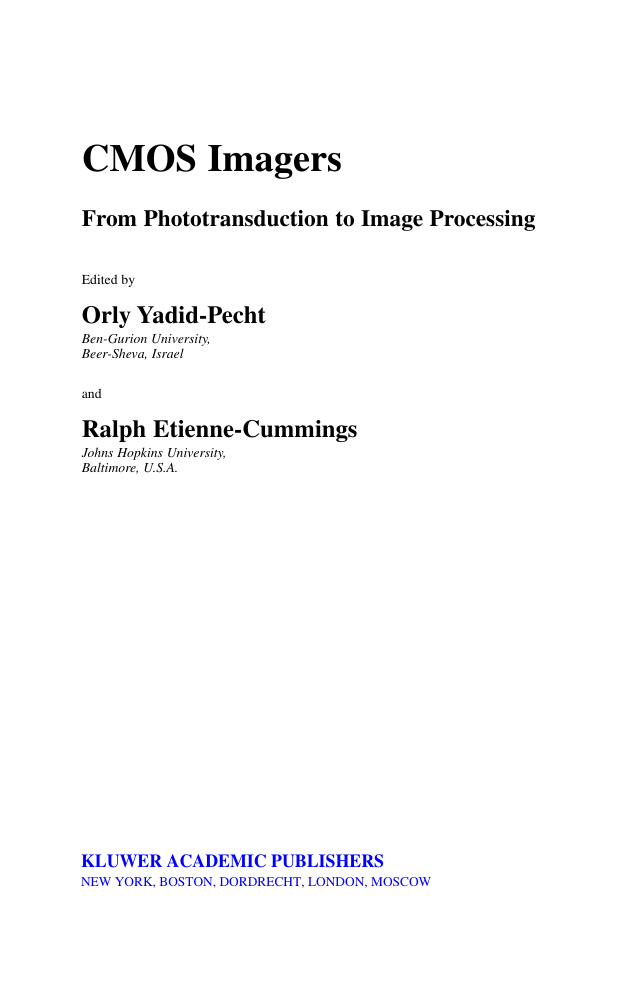


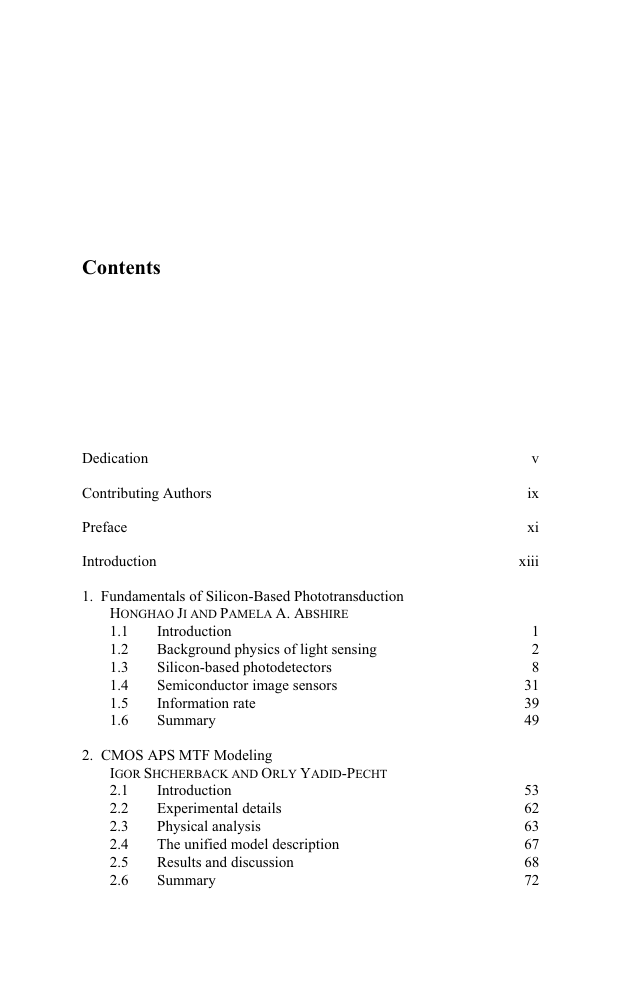
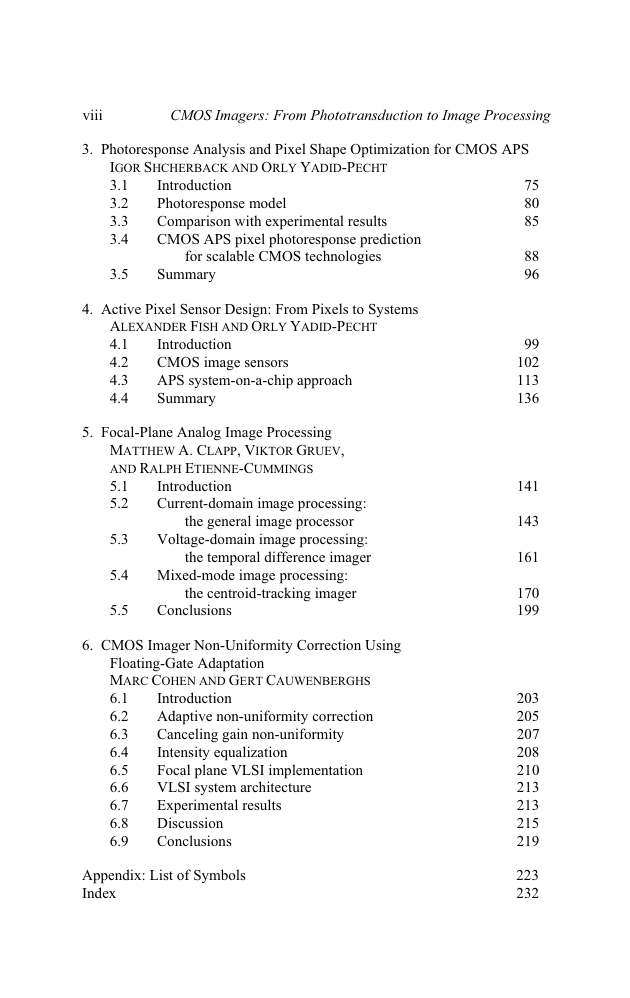
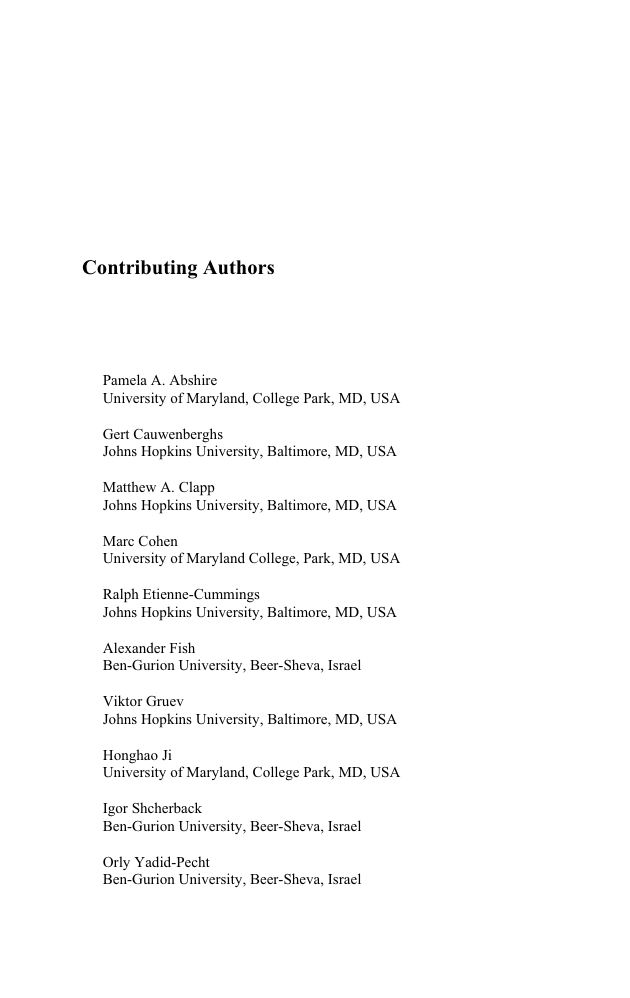
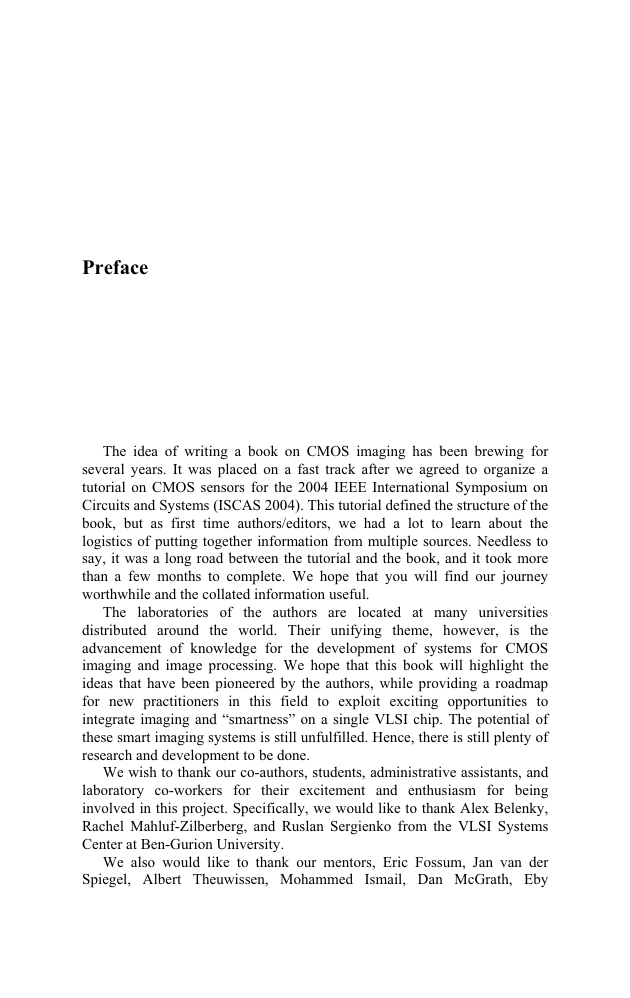








 2023年江西萍乡中考道德与法治真题及答案.doc
2023年江西萍乡中考道德与法治真题及答案.doc 2012年重庆南川中考生物真题及答案.doc
2012年重庆南川中考生物真题及答案.doc 2013年江西师范大学地理学综合及文艺理论基础考研真题.doc
2013年江西师范大学地理学综合及文艺理论基础考研真题.doc 2020年四川甘孜小升初语文真题及答案I卷.doc
2020年四川甘孜小升初语文真题及答案I卷.doc 2020年注册岩土工程师专业基础考试真题及答案.doc
2020年注册岩土工程师专业基础考试真题及答案.doc 2023-2024学年福建省厦门市九年级上学期数学月考试题及答案.doc
2023-2024学年福建省厦门市九年级上学期数学月考试题及答案.doc 2021-2022学年辽宁省沈阳市大东区九年级上学期语文期末试题及答案.doc
2021-2022学年辽宁省沈阳市大东区九年级上学期语文期末试题及答案.doc 2022-2023学年北京东城区初三第一学期物理期末试卷及答案.doc
2022-2023学年北京东城区初三第一学期物理期末试卷及答案.doc 2018上半年江西教师资格初中地理学科知识与教学能力真题及答案.doc
2018上半年江西教师资格初中地理学科知识与教学能力真题及答案.doc 2012年河北国家公务员申论考试真题及答案-省级.doc
2012年河北国家公务员申论考试真题及答案-省级.doc 2020-2021学年江苏省扬州市江都区邵樊片九年级上学期数学第一次质量检测试题及答案.doc
2020-2021学年江苏省扬州市江都区邵樊片九年级上学期数学第一次质量检测试题及答案.doc 2022下半年黑龙江教师资格证中学综合素质真题及答案.doc
2022下半年黑龙江教师资格证中学综合素质真题及答案.doc